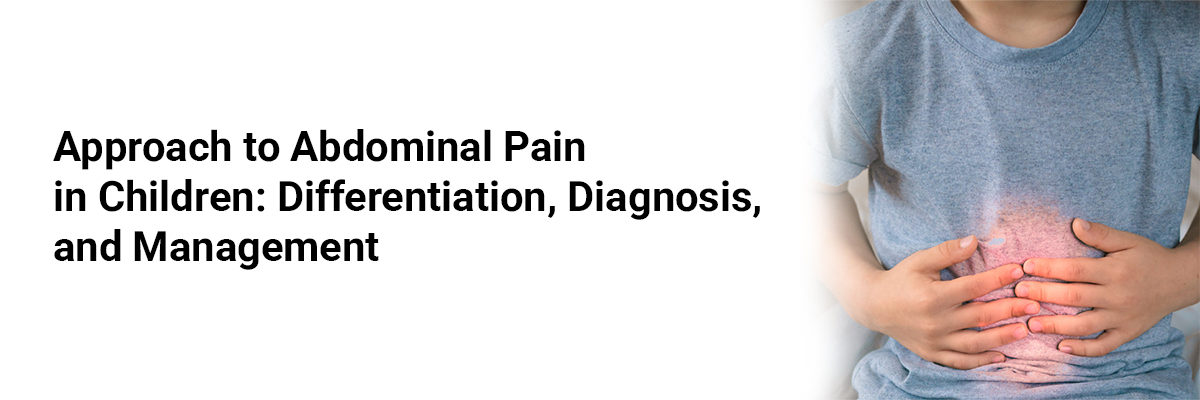
Approach to Abdominal Pain in Children: Differentiation, Diagnosis, and Management
Acute abdominal pain (AP) is a frequent reason for visits to the emergency department (ED) and outpatient clinics, accounting for approximately 5–10% of ED presentations (1,2). It is generally defined as pain of nontraumatic origin with a maximum duration of 5 days and can range from mild and self-limiting to severe and life-threatening. Urgent causes of AP require prompt intervention within 24 hours, particularly in cases involving ischemia, to avoid complications. Nonurgent causes, while sometimes uncomfortable, typically do not need immediate treatment and can be managed conservatively (2,3). The underlying cause of acute AP often varies with age and sex, making classification by age a useful diagnostic strategy. This helps guide the appropriate use of laboratory testing, imaging, and definitive treatment pathways. Among nonsurgical diagnoses, the most prevalent are upper respiratory tract infections (alone or with otitis media/sinusitis) accounting for 23.7%, followed by abdominal pain of uncertain etiology and gastroenteritis (each 15.4%), constipation (9.4%), and urinary tract infections (8%). These causes are mostly benign and self-limiting (2,4).
Despite this, up to 20% of AP cases in the ED have a surgical etiology and must be carefully evaluated to avoid delays in necessary surgical intervention. In infants under 1 year, the most common surgical causes are incarcerated inguinal hernia (45.1%) and intussusception (41.9%), while these are rare in older children. For children over 1 year of age, acute appendicitis is the leading surgical cause (64.0%), followed by incarcerated hernia (7.5%), trauma (16.3%), intussusception (6.3%), intestinal obstruction (1.3%), and ovarian torsion (1.3%). Early and accurate recognition of appendicitis is vital(2,5). Pathological analysis of resected appendices shows 15.6% of cases present as early appendicitis, 64.1% with suppurative or gangrenous changes, and 20.3% as perforated. This progression highlights the importance of early diagnosis and intervention to reduce complications. Accurate differentiation between surgical and nonsurgical causes of abdominal pain is critical to ensure timely management, improve outcomes, and minimize unnecessary interventions (2).
Differentiating Surgical from
Nonsurgical Acute Abdominal Pain
Accurate
differentiation between surgical and nonsurgical etiologies of acute abdominal
pain is crucial for guiding timely intervention and avoiding unnecessary
procedures. The clinical history can offer significant clues. Surgical
abdominal pain is typically acute in onset, progressively worsening, and often
localized. In such cases, pain frequently precedes vomiting, and features such
as bilious emesis, hematochezia, or a history of prior abdominal surgery raise
concern for a potentially urgent surgical pathology.In contrast, nonsurgical
abdominal pain is often more diffuse or midline, with a stable intensity over
time. Vomiting, if present, generally precedes the onset of pain, and the
overall symptom duration tends to be longer without rapid clinical
deterioration. These characteristics are more consistent with self-limiting or
functional gastrointestinal conditions(2,5).
On
physical examination, patients with a surgical abdomen are often systemically
ill-appearing, lethargic, and may demonstrate abdominal distension. Bowel
sounds may be absent or hyperactive, and localized tenderness is common,
particularly in the presence of peritoneal signs such as guarding, rigidity, or
rebound tenderness, which suggest intra-abdominal inflammation or irritation(2,3,6).
In
contrast, patients with nonsurgical etiologies are usually well-appearing and
hemodynamically stable. Abdominal examination typically reveals normal bowel
sounds, no distension, and only diffuse, non-localized tenderness without signs
of peritoneal irritation(2).
Initial
diagnostic evaluation should be tailored according to the suspected etiology.
In cases where a surgical cause is suspected, laboratory investigations should
include a complete blood count, serum electrolytes, liver function tests,
amylase, lipase, urinalysis, and, in postmenarchal females, a pregnancy test.
Imaging studies, such as an abdominal X-ray (particularly indicated in patients
with prior abdominal surgery, distension, or bilious vomiting) and abdominal
ultrasonography, are essential to further delineate the diagnosis.For
nonsurgical cases, investigations should be symptom-directed and
individualized. Testing may include stool studies, urinary analysis, or
abdominal imaging depending on the clinical context, but extensive workup may
be unnecessary in clearly benign or functional presentations(2).While a detailed discussion of condition-specific treatment
modalities is beyond the scope of this review, several general management
principles merit consideration.While a detailed discussion of
condition-specific treatment modalities is beyond the scope of this review,
several general management principles merit consideration(2,7).
Recurrent
Abdominal Pain (RAP): Evaluation and Management
Recurrent abdominal pain (RAP) is defined as the occurrence of at least three episodes of abdominal pain over a period of three months. It includes both organic and functional causes, although up to 95% of cases are attributed to functional abdominal pain disorders (FAPD). Organic causes of RAP, while less common, include peptic ulcer disease, cholelithiasis, chronic pancreatitis, abdominal tuberculosis, inflammatory bowel disease (IBD), parasitic infections, and urinary tract infections (UTI) (8).
The evaluation of RAP begins with a thorough clinical history that explores the characteristics of the pain, associated gastrointestinal or systemic symptoms, and the presence of psychological or environmental stressors. A detailed physical examination is essential, particularly to identify alarm symptoms such as weight loss, gastrointestinal bleeding, growth failure, or persistent vomiting, which may suggest an underlying organic etiology. Basic laboratory investigations play a key role in the initial assessment. These typically include complete blood counts, urine and stool examinations, serum albumin, and inflammatory markers to help identify chronic organic conditions. Fecal calprotectin (FCP) is a particularly useful non-invasive test with high sensitivity for differentiating IBD from irritable bowel syndrome (IBS). Imaging studies, especially abdominal ultrasonography (USG), can aid in detecting structural abnormalities such as gallstones, biliary obstruction, chronic pancreatitis, bowel wall thickening, or malrotation. In selected cases, endoscopic procedures are warranted to evaluate for conditions like peptic ulcer disease, IBD, abdominal tuberculosis, and Helicobacter pylori infection (8,9).
Management strategies depend on the underlying cause. Organic conditions require specific medical or surgical treatment based on the diagnosis. In contrast, FAPD is managed primarily through patient education and reassurance, supported by pharmacological treatment when needed. For patients with persistent symptoms despite standard therapy, non-pharmacological interventions such as cognitive behavioral therapy, hypnotherapy, yoga, and percutaneous electrical nerve stimulation may be beneficial (8).
References:
1. Caperell
K, Pitetti R, Cross KP. Race and Acute Abdominal Pain in a Pediatric Emergency
Department. Pediatrics. 2013 Jun 1;131(6):1098–106.
2. Hijaz NM, Friesen CA. Managing acute
abdominal pain in pediatric patients: current perspectives. Pediatr Health Med
Ther. 2017 Jun 29;8:83–91.
3. Imaging strategies for detection of
urgent conditions in patients with acute abdominal pain: diagnostic accuracy
study | The BMJ [Internet]. [cited 2025 May 30]. Available from:
https://www.bmj.com/content/338/bmj.b2431
4. Erkan T, Çam H, Özkan HÇ, Kiray E,
Erginoz E, Kutlu T, et al. Clinical spectrum of acute abdominal pain in Turkish
pediatric patients: A prospective study. Pediatr Int. 2004;46(3):325–9.
5. Tseng YC, Lee MS, Chang YJ, Wu HP.
Acute Abdomen in Pediatric Patients Admitted to the Pediatric Emergency
Department. Pediatr Neonatol. 2008 Aug;49(4):126–34.
6. Eskelinen M, Lipponen P. Usefulness of
history-taking in non-specific abdominal pain: a prospective study of 1333
patients with acute abdominal pain in Finland. Vivo Athens Greece.
2012;26(2):335–9.
7. Guideline for the Diagnostic Pathway in
Patients with Acute Abdominal Pain | Digestive Surgery | Karger Publishers
[Internet]. [cited 2025 May 30]. Available from:
https://karger.com/dsu/article-abstract/32/1/23/117534/Guideline-for-the-Diagnostic-Pathway-in-Patients?redirectedFrom=fulltext
8. Seetharaman J. Recurrent Abdominal Pain
in a Child - Evaluation and Management. Indian J Pediatr. 2025 May
1;92(5):526–34.
9. Quak SH. Recurrent abdominal pain in
children: a clinical approach. Singapore Med J. 2015 Mar;56(3):125–8.













Please login to comment on this article